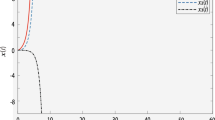Abstract
The stabilization and H ∞ control of nonlinear differential algebraic systems (NDAS) are investigated using the Hamiltonian function method. Firstly, we put forward a novel dissipative Hamiltonian realization (DHR) structure and give the condition to complete the Hamiltonian realization. Then, based on the DHR, we present a criterion for the stability analysis of NDAS and construct a stabilization controller for NDAS in absence of disturbances. Finally, for NDAS in presence of disturbances, the L 2 gain is analyzed via generalized Hamilton-Jacobi inequality and an H ∞ control strategy is constructed. The proposed stabilization and robust controller can effectively take advantage of the structural characteristics of NDAS and is simple in form.
Similar content being viewed by others
References
Venkatasubramanian V, Schättler H, Zaborszky J. Dynamics of large constrained nonlinear systems—a taxonomy theory. Proc IEEE, 1995, 83(11): 1530–1561
Hill D J, Mareels I M. Y. Stability theory for differential algebraic systems with application to power systems. IEEE Trans Circuits Syst, 1990, 37(11): 1416–1423
McClamboch N H, Wang D W. Feedback stabilization and tracking of constrained robots. IEEE Trans Autom Control, 1988, 33(5): 419–426
Campbell S L. A general method for nonlinear descriptor systems: A example from robotic path control. Proceedings of the 27th IEEE Conference on Decision and Control, Austin, Texas, Dec 1988, 630–631
Zimmer G, Meier J. On observing nonlinear descriptor system. Syst Control Lett, 1997, 32: 43–48
Liu Y Q, Li Y Q. Stabilization of nonlinear singular systems. Proceedings of the American Control Conference, Philadelphia, Pennsylvania, Jun 1998, 2532–2533
Wang J, Chen C, La Scala M. Parametric adaptive control of multimachine power systems with nonlinear loads. IEEE Trans Circuits Syst I-Regul Pap, 2004, 51(2): 91–100
Wang H S, Yung C F, Chang F R. H∞ control for nonlinear descriptor systems. IEEE Trans Autom Control, 2002, 47(11): 1919–1925
Chiang H D, Fekih-Ahmed L. On the direct method for transient stability analysis of power system structure preserving models. Proceedings of 1992 IEEE International Symposium on Circuits and Systems, 1992, 5: 2545–2548
Praprost K L, Loparo K A. An energy function method for determining voltage collapse during a power system transient. IEEE Trans Circuits Syst I-Regul Pap, 1994, 41(10): 635–651
Ortega R, Van der Schaft A J, Maschke B, et al. Interconnection and damping assignment passivity-based control of port-controlled Hamiltonian systems, Automatica, 2002, 38(4): 585–596
Ortega R, Van der Schaft A J, Mareels I, et al. Putting energy back in control. IEEE Control Syst Mag, 2001, 21(2): 18–33
Wang Y, Cheng D, Hong Y. Stabilization of synchronous generators with Hamiltonian function approach. Int J Syst Sci, 2001, 32(8): 971–978
Cheng D, Xi Z, Hong Y, et al. Energy-based stabilization in power systems. Proceedings of the 14th IFAC World Congress, Beijing, China, 1999, 297–303
Sun Y, Shen T, Ortega R, et al. Decentralized controller design for multimachine power systems based on Hamiltonian structure. Proceedings of the 40th IEEE Conference on Decision and Control, Orlando, 2001, 4: 3045–3050
Wang Y, Cheng D, Li C, et al. Dissipative Hamiltonian realization and energy-based L2 disturbance attenuation control of multi-machine power systems. IEEE Trans Autom Control, 2003, 48(8): 1428–1433
Bachamann R, Brüll L, Mrziglod T, et al. On methods for reducing the index of differential-algebraic equations. Comput Chem Eng, 1990, 14: 1271–1273
Gear C W. Differential-algebraic equation index transformation. SIAM J Sci Stat Comp, 1988, 9: 39–47
Liu X P, Čelikovský S. Feedback control of affine nonlinear singular control systems. Int J Control, 1997, 68(4): 753–774
Author information
Authors and Affiliations
Corresponding author
Rights and permissions
About this article
Cite this article
Liu, Y., Li, C. & Wu, R. Feedback control of nonlinear differential algebraic systems using Hamiltonian function method. SCI CHINA SER F 49, 436–445 (2006). https://doi.org/10.1007/s11432-006-2004-8
Received:
Accepted:
Issue Date:
DOI: https://doi.org/10.1007/s11432-006-2004-8



